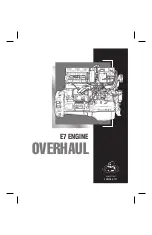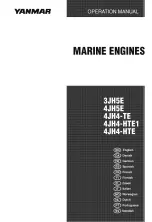
LEHR
|
ALL RIGHTS RESERVED 2012-2013
19
INSTALLING THE PROPELLER
• Be sure to install the thrust washer before installing the pr opeller, otherwise the lower case and propeller
boss could be damaged.
• Be sure to use a new cotter pin and bend the ends over secure ly. Otherwise the propeller could come
off during operation and be lost.
1. Apply corrosion resistant grease to the propeller shaft.
2. Install the thrust washer, and propeller on the propeller shaft.
3. Install the washer. Tighten the propeller nut until there is no forward-and-backward movement.
4. Align the propeller nut with the propeller shaft hole. Ins ert a new cotter pin in the hole and bend the
cotter pin ends.
NOTE: If the propeller nut does not align with the propeller shaft hole after tightening it, loosen the
nut until it aligns with the hole.
MAINTENANCE
WOOD BLOCK
ANTI-CAVITATION PLATE
PUT A WOOD BLOCK BETWEEN THE PROPELLER AND
THE ANTI-CAVITATION PLATE TO KEEP IT FROM TURNING
COTTER PIN
N PLATE
ER AND
M TURNING
WARNING: Do not use your hand to hold the propeller when loosening or tightening the propeller nut. Put
a wood block between the anti-cavitation plate and the propeller to prevent the propeller from
turning.
PROPELLER SELECTION
Your LEHR outboard engine is supplied with a propeller that matches the needs of a boat most suited to an
engine of its size. If you feel you are not getting optimal performance from the engine on your boat, a
different pitch propeller could help. The performance of your outboard motor will be affected if you choose a
different propeller, as an incorrect choice could adversely affect performance and could also seriously damage
the motor. Engine speed depends on the propeller size and boat load. If engine speed is too high or too low
for good engine performance, this will have an adverse effect on the engine. For a greater operating load, a
smaller-pitch propeller is more suitable as it enables the correct engine speed to be maintained. Conversely,
a larger-pitch propeller is more suitable for a smaller operation load.
1. Propeller diameter in inches.
2. Propeller pitch in inches.
3. Type of propeller (propeller mark).
NOTE: Select a propeller which will allow the engine to reach the middle or upper half of the operation range
at full throttle with the maximum boat load. In operation conditions such as light boat loads, do not
allow the engine RPM to rise above the maximum recommended range, reduce the throttle setting to
maintain the engine in the proper operation range.
X
1
2
3










































